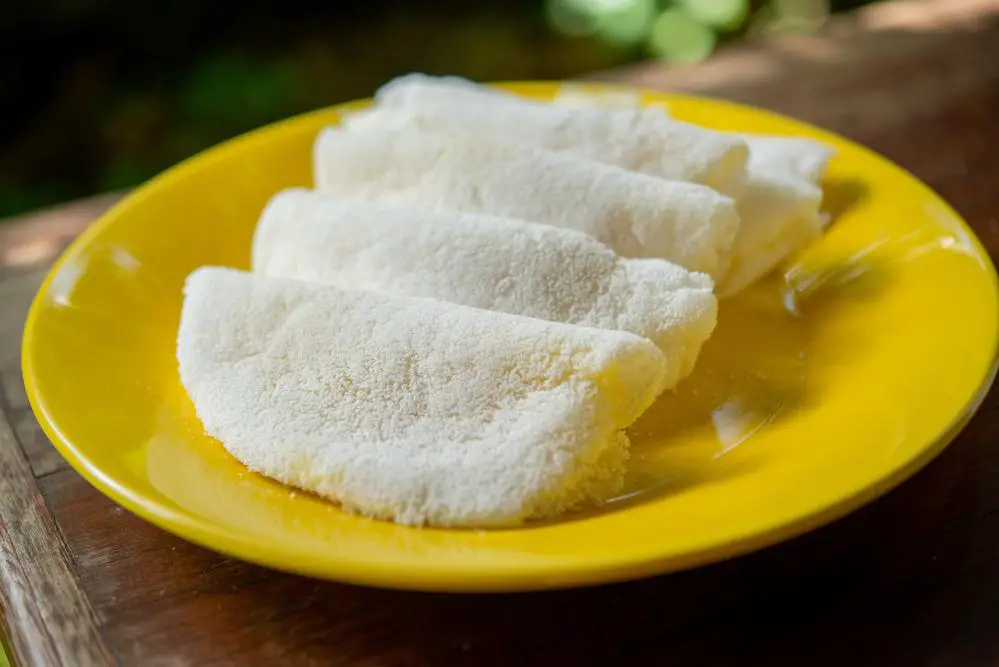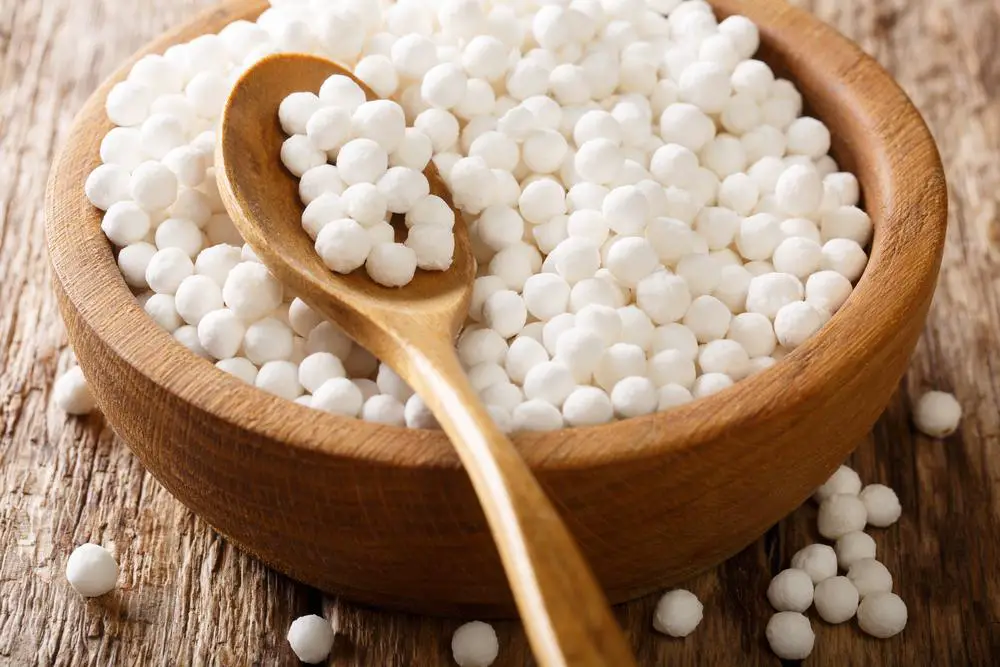With the rise of veganism, folks wonder about a surprising amount of foods. Tapioca, an ingredient often found in various products, is one such example. This might seem straightforward, but it gets a bit sticky considering tapioca’s versatility. Tapioca has many uses, including acting as a binding agent in vegan cheese and baked goods. So, in its raw form, tapioca starch is indeed vegan-friendly, as it originates from the cassava root – a plant-based source.
But hold your horses because it’s not as simple as processed foods containing tapioca. Some products, such as certain types of tapioca pudding, aren’t vegan due to incorporating dairy or other non-vegan ingredients. So, while tapioca is vegan, not everything made with it follows suit. Checking the ingredient list when in doubt is always a good idea.
What Is Tapioca?
Have you ever asked yourself, “What is tapioca?” You’re not alone. Tapioca is a starch derived from the cassava root, a plant native to South America. It’s a staple in many tropical diets. It’s often sold as fine, powdery flour or molded into small pearls, which melt into a gooey consistency when cooked. The starch and tapioca flour are interchangeable in most recipes, and they offer a gluten-free alternative to wheat flour in all sorts of dishes.
Texture-wise, tapioca starch feels more granular, similar to cornstarch, while tapioca flour has a consistency akin to fine wheat flour. Both make for excellent thickeners in sauces and soups, although tapioca flour may make your dish a tad cloudy. Is the veggie burger falling apart? Throw in some tapioca starch. Need a gluten-free thickener that’s not cornstarch? Tapioca’s got your back. Just remember that the ratio of other ingredients might need some tweaking to achieve the right consistency with tapioca flour.
Tracing Tapioca’s Roots: How Is It Made?
So, what happens between the cassava root in the ground and the tapioca in your kitchen? Well, the journey of tapioca starts with the starch extracted from the cassava root. Then it’s processed – usually by grinding and washing – into a dry, granular substance, which can be used directly or further transformed into fine flour or even shaped into tapioca pearls, which find their way into all sorts of things from bubble tea to dessert pudding.
Tapioca’s got a neutral flavor, so it doesn’t muck up the taste of the dishes it’s in – letting the other flavors shine through. That’s why you’ll find it in diverse baked goods and dishes. And don’t worry, it’s not all empty carbs. Tapioca gives you a bit of dietary fiber and a few essential vitamins and minerals thrown in for good measure, though it does pack a carbohydrate punch. It doesn’t contain significant amounts of fat or protein, but it’s a champ in acting as a replacement for wheat in baking, making it a useful staple for dairy-free and gluten-free diets.
 Understanding the Versatility: The Many Uses of Tapioca
Understanding the Versatility: The Many Uses of Tapioca
Tapioca’s a natural kitchen multi-tasker, finding its way into an impressive range of foods and drinks.
Tapioca Starch & Flour
“Tapioca starch and tapioca flour… Aren’t they the same thing?” Not quite, my friend. While starch and flour are derived from the cassava root and share a similar flavor profile, minor yet essential differences exist. Tapioca starch sports a granular, powdery texture. On the flip side, tapioca flour has that fine feel, not unlike wheat flour. So, they’re twin siblings with some individuality thrown in.
Both can be thickeners, with tapioca starch being the go-to option to avoid a cloudy appearance in your dish. If you’re hunting for a gluten-free alternative to wheat flour for your recipes, tapioca flour is a sound choice. No gluten, no problem. That said, you might have to shuffle around ratios of other ingredients to hit that sweet spot of desired consistency. Whether you choose tapioca starch or flour, each adds a unique touch to the dishes and brings culinary magic.
Tapioca in Bubble Tea
You know those funky little balls at the bottom of a boba tea cup that you suck up through a big ol’ straw? Well, those are made of tapioca. Boba tea is a trendy beverage that has taken the world by storm. It’s like a party for your taste buds with its mix of tea, syrup, and milk, topped off with those delightful chewy pearls. But hang on a second – is it suitable for a vegan diet?
The truth is, it’s a bit complex. Not all bubble tea shops whip up vegan-friendly brews. It all depends on the ingredients they choose if your bubble tea is fruit-based – bingo! It’s likely vegan. But if it’s milk-based or even a blend of milk and fruit, we have a problem. Cow’s milk is a no-go in the vegan world. So, remember to ask about the ingredients next time you hit up your local bubble tea shop. Better safe than sorry, right?

From Starch to Pudding: How Products Influence If Tapioca Is Vegan
Okay, so we know tapioca is a champ in the vegan world. It’s made from a plant, after all. But here’s where things get a tad tricky – how it’s used can influence its vegan status. While pure tapioca is all good, it’s often mixed with other ingredients that may or may not pass the vegan test. Tapioca has this funky, bubbly texture that makes it a superstar in many dishes, and sometimes, these dishes include non-vegan elements. Ain’t that a bummer?
Take tapioca pudding, for instance. Traditional recipes often use milk or eggs, a big no-no in the vegan playbook. But it isn’t all doom and gloom – there’s always a way to adapt recipes to suit a vegan lifestyle. You can enjoy tapioca’s glorious, gooey texture in all your favorite dishes without straying from your vegan principles with the correct substitutions.
The Exceptions: Not All Tapioca-Based Products Are Vegan
Now, hold up, folks. Not all tapioca products are created equal. There are some exceptions to the rule. Take tapioca starch, for example. It’s generally acceptable for those sticking to plant-based diets. But here’s the catch – some brands sneak in non-vegan additives and sweeteners. It’s like putting ketchup on a hot dog and pretending it’s still a hot dog. The same goes for products like Bob’s Red Mill Small Pearl Tapioca. While the company says it’s vegan, its tapioca starch isn’t touted as such. So you have to keep your eyes open and do some detective work. Read those labels like they’re the latest gossip, and you’ll be fine.
Staying True to the Vegan Lifestyle: Tapioca Substitutions in Vegan Food Products
In the spirit of keeping things plant-based, tapioca has carved out a place for itself in vegan substitutes. Its unique properties make it a handy tool in the vegan kitchen. Case in point: vegan cheese. Who would’ve thought right? But it’s true! Tapioca is used to help replicate the texture and meltiness you would usually get from the real deal. Now, it isn’t a source of protein, but it does the trick when you’re craving a cheesy treat minus the moo.
And hey, tapioca isn’t just a one-trick pony. It can dance its way into puddings, replacing ingredients like egg whites. It’s a godsend for folks with celiac disease, too. Tapioca is gluten-free, making it a great alternative to wheat-based products. You’ll even find it in certified vegan pudding recipes, adding that perfect touch of creaminess. Imagine this: a vegan tapioca pudding recipe with ½ cup of tapioca, plant-based milk, a dash of maple syrup, and a pinch of teaspoon salt, all topped off with coconut whipped cream. Now, isn’t that a pretty picture in a glass container? It shows that with the right recipe and maybe some strawberry rhubarb, you can put the ‘yum’ in tapioca and keep it vegan.
Final Take
Now, all this doesn’t mean tapioca is the bad guy. It’s like that buddy who always shows up for a Friday night game but never brings anything. You’re glad to see him, but wish he would at least bring some chips. Tapioca has its place in the food world, especially if you’re talking about those little boba pearls that add a fun twist to your bubble tea or even in traditional dishes like Brazilian feijoada, served with rice and collard greens.
But remember, everything is in moderation. A sprinkle of those pearls – sugar and vanilla flavored, of course – goes a long way. And if you’re thinking of cooking up a plant-based version of something, add tapioca to the mix. Give it a nice consistency. Remember, you still have to balance it with more nutritious stuff. Ultimately, you can flex those culinary muscles and cook something good – remember to heat and stir!

